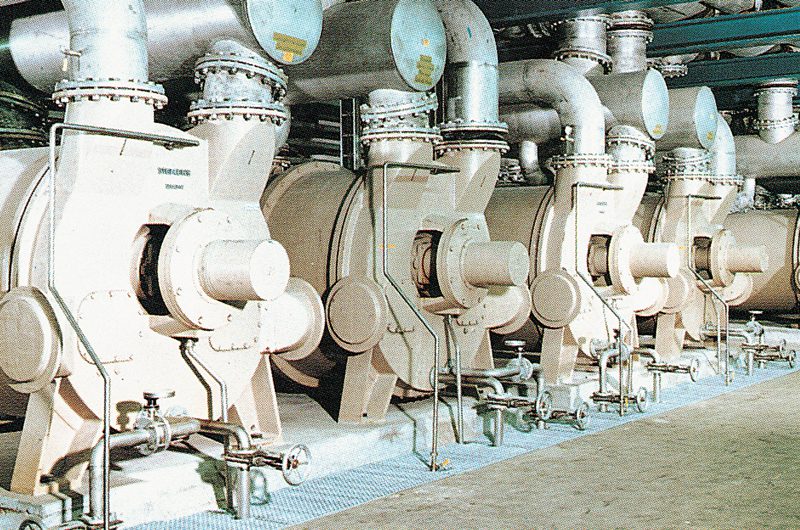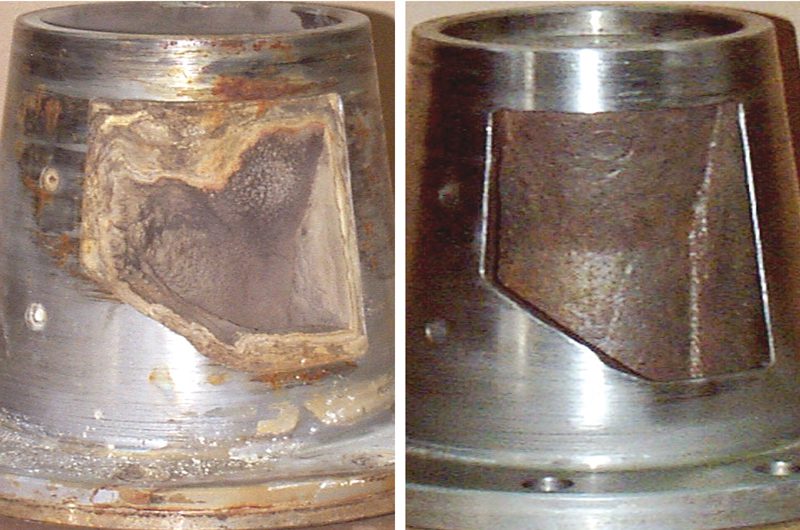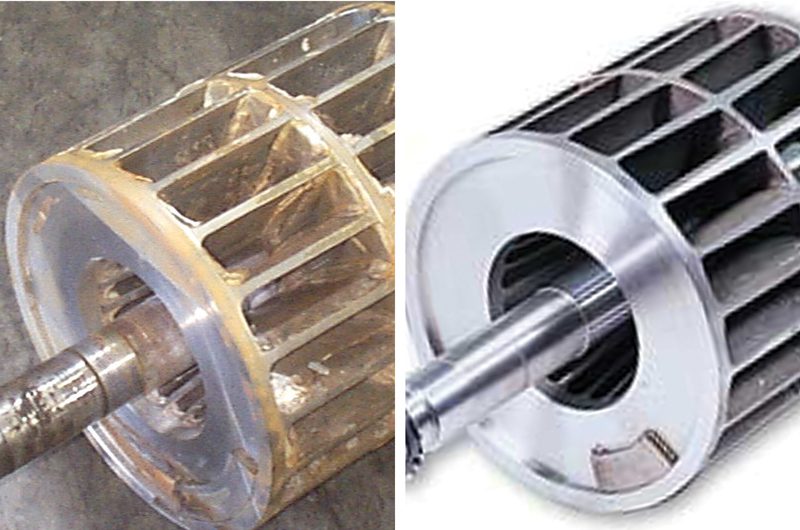Vacuum Pump Descaling with RYDLYME
RYDLYME is the perfect vacuum pump descaler to circulate and remove mineral deposits from vacuum pumps! Vacuum pump descaling is made easy with RYDLYME Biodegradable Descaler. Simply circulate RYDLYME through the vacuum pump removing mineral and scale build-up in a safe and timely manner.
RYDLYME Biodegradable Descaler is used to safely and efficiently dissolve tough mineral deposits such as water scale, limescale, calcium, and rust from boilers, chillers, cooling towers, condensers, heat exchangers, struvite, vacuum pumps, and more!
RYDLYME vacuum pump descaler is the ONLY product of its kind that is truly non-toxic and non-hazardous! Unlike other chemical descalers and traditional harsh acids, RYDLYME descaler can be safely handled by personnel (you can even hold it in your hand without injury!) and there are NO transportation or handling restrictions! It can be safely disposed of in normal plant sewers, even in the case of an accidental spill at the full concentration!
RYDLYME vacuum pump descaler is certified by an EPA-approved testing laboratory as a fully biodegradable and environmentally non-hazardous chemical, even at 100% concentration WITHOUT neutralization! While other chemical descalers claim to be biodegradable, it does not equate to overall safety. In fact, some of them are classified as hazardous chemicals and have special handling requirements.
Check out our YouTube Channel or click here for videos!
Vacuum Pump Cleaning Procedure
When water scale, lime, mud, and rust accumulate on the water side of liquid ring compressors or vacuum pumps, this not only drastically reduces volume and efficiency but also increases electrical consumption. This information is quantified by measuring the before & after the draw of amperage in your drive motors multiplied by the cost per kW/hr at your facility.
By performing regular RYDLYME cleanings, your vacuum pump will continue running efficiently and avoid potential costly shutdowns. But the benefits don’t stop here; shutdowns caused by scale in vacuum pumps can result in, but are not limited to, under-deposit corrosion, unbalanced rotors, reduced seal water supply, and overworked drive motors!
In order to effectively and safely return operating efficiency to Nash, SIHI, Somarakis, Vooner, and other liquid ring vacuum pumps, the following procedure should be followed:
Vacuum Pump Descaling Procedure
- Write down current or “before” amperage readings, CFM at vacuum capacity, and the vacuum in inches of mercury.
- Take the unit out of service.
- Insert “blank” in the flanges of discharge piping (see figure 1) and tighten flange bolts.
- Remove the bottom drain plug and allow all water to drain from the pump casing. Replace the bottom plug.
- Break seal water piping and attach RYDLYME pump discharge hose.
- Remove the top plug, attach the return hose and place the other ends of the return hose in the RYDLYME receiver.
- Add the prescribed quantity of RYDLYME to the receiver and start the pump.
- In some instances, additional water may be required to maintain circulation. Add only enough water to maintain circulation.
- Tighten pump seal packing to minimize leakage of RYDLYME.
- After 15 minutes of RYDLYME circulation, turn the pump rotor 90 degrees by pulling on the drive belts or jacking the starter switch.
- Every 15 minutes thereafter, turn the pump rotor 90 degrees to assure a thorough cleaning of all interior parts of your pump, including the hub, cones, and rotor.
- Continue the circulation of RYDLYME for the recommended time frame.
- After the recommended circulation time, with the intermittent turning of the rotor, the pump should be clean and the rotor should turn freely.
- Shut off your pump and add a water supply hose to the receiving bucket. Disconnect your return hose from the pump system and put it in a drain. Turn on the water supply and the circulation pump, and begin flushing out the unit for 20 to 30 minutes or until the discharge runs clear.
- Shut off the circulation pump and disconnect all the RYDLYME hoses.
- Reconnect the seal water piping.
- Remove the “blank” in the flanges of the discharge piping and tighten the flange bolts.
- Return pump or compressor to service.
- Adjust the seal water rate to the manufacturer‘s recommendations.
- After the unit has stabilized, write down current or “after” amperage readings, CFM at vacuum capacity, and vacuum in inches of mercury.
- Compare “before” readings with the “after” readings. The difference between the “before” and “after” amperage readings multiplied by the cost per kW/hr at your facility, will help you determine the short payback time required to justify future RYDLYME cleanings. RYDLYME cleanings of your liquid ring vacuum pumps should be performed on a preventative or predictive maintenance schedule.
RYDLYME Procedure for Descaling Siemens Vacuum Pumps
In order to effectively and safely return operating efficiency to your Siemens vacuum pump, the following instructions should be followed. When cleaning Siemens vacuum pumps there are two methods we propose, please utilize one of these techniques. If your pump has a separator tank, we recommend you drill and tap the side wall of the separator tank three inches from the bottom (these taps should be no less than one inch). If your pump does not have the separator tank, you will need to drill and tap the top of the blank flange (see diagrams below). Either method will allow the vacuum pump to be completely flooded with the RYDLYME solution and provide a proper return point.
Caution: Do not utilize the seal water feed when cleaning a Siemens vacuum pump, Siemens has pressure-sensitive packing that can be compromised if the feed rate is too high.
- Write down current or “before” amperage readings, CFM at vacuum capacity, and the vacuum in inches of mercury.
- Take the unit out of service.
- Shut the water off to the unit.
- Remove the “total drain plug” and allow the unit to completely drain.
- Insert “blanks” on the flange manifold, separator flange, and both the top and/or side discharge flanges, then tighten the bolts.
- Take a screwdriver and poke it through any deposit that might be blocking or impeding the flow during the circulation on the “total drain port.”
- Hook up one circulation hose to the pump discharge and the other end to the total drain port.
- Hook your second hose up to the 1” male fitting on either the separator tank or the blank flange (depending on your situation), and return it to the receiver bucket.
- Add the prescribed quantity of RYDLYME to the receiver bucket (see chart on brochure) and start pumping into the vacuum pump.
- Once you have introduced the recommended amount of RYDLYME, you will want to use water as the makeup to complete the circulation. Add only enough water to maintain circulation.
- During the cleaning process, additional water may be needed to maintain circulation. It is common to keep the level inside of the receiving bucket 12 inches below the top.
- After 30 minutes of RYDLYME circulation, it is best to start turning the rotor 90 degrees every 15 minutes by pulling on the drive belts or jacking the starter switch. This will assure a thorough cleaning of the hub and rotor.
- Continue the RYDLYME circulation for the designated amount of time. After the designated amount of circulation time, the pump should be clean and the rotor should turn freely. If not, the pump may have been more fouled than anticipated. In this case, a longer circulation period, more RYDLYME, or both, may be needed to completely clean the unit.
- Shut off the circulating pump and disconnect the hose from the receiving bucket and put it in a drain.
- Now you are ready to flush the unit.
- Put a water supply hose into the receiving bucket, turn the circulation pump on and flush out the unit for 20 to 30 minutes or until the discharge runs clear.
- Disconnect all the RYDLYME hoses and the circulation pump.
- Replace your “total drain plug.”
- Remove all of the blanks in the flanges and tighten up the flange bolts.
- Open the seal water valves.
- Return the pump to service.
- Adjust the seal water rate to the manufacturer‘s recommendations.
- After the unit has stabilized, write down the current or “after” amperage readings, CFM at vacuum capacity, and vacuum in inches of mercury.
- Compare the “before” and “after” readings. The difference between the “before” and “after” amperage readings multiplied by the cost per kW/hr at your facility, will help you determine the short payback time required to justify future RYDLYME cleanings.
- RYDLYME cleanings of your liquid ring vacuum pumps should be performed on a preventative or predictive maintenance schedule.




